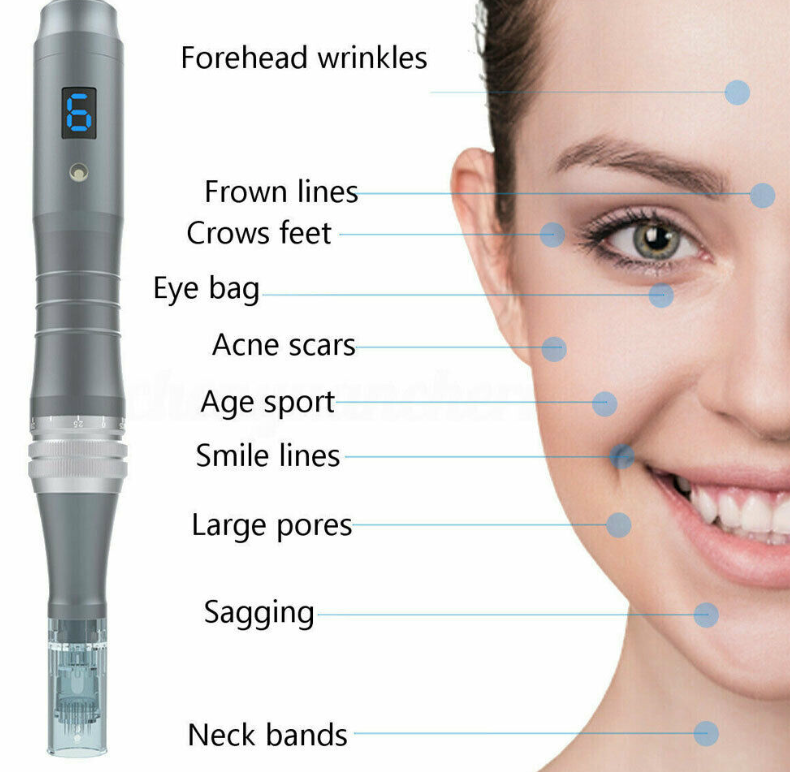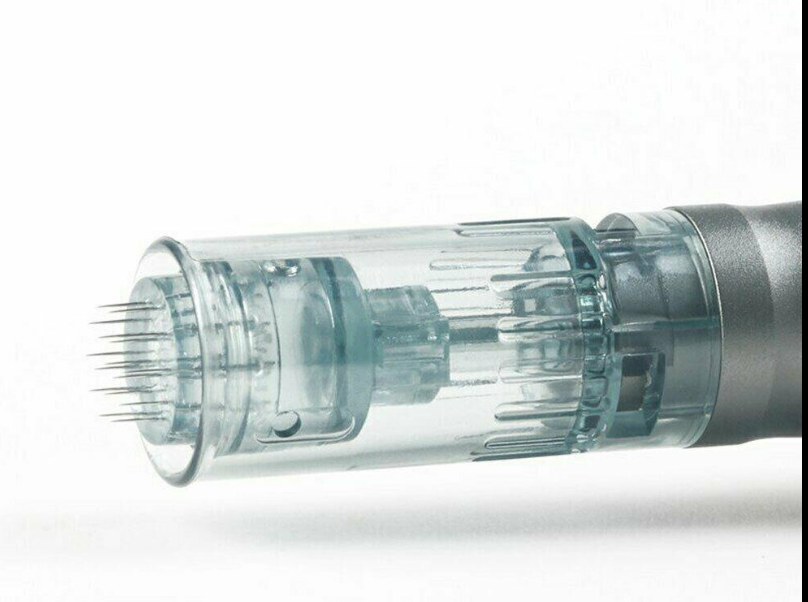What is Medical Micro-Needling?
For skin micro-needling, we use an electric skin needling device made especially for this purpose. The device is a pen-shaped device studded with 12 very fine needles. It is a medical device used in micro-needling to break down old scar tissue and to stimulate skin cells to proliferate. This cell multiplication results in the formation of new tissue layers of elastin and collagen fibers as well as in new capillaries for an improved blood supply.
What conditions can be treated or improved with Medical Micro-Needling?
- Mild to moderate acne scarring; any new or old scars
- Fine lines and wrinkles;
- Loose, lax skin;
- Skin texture and pore size
- Stretch marks
How does Medical Micro-Needling work?
The device slides along the skin, penetrating the upper layers of the skin to a depth of up to 2mm to create numerous tiny needle wounds. The procedure prompts the body to respond through the creation of new collagen and elastin fibers. In response to the stimulus, the skin plumps and thickens, reducing the appearance of scars, and fine lines and wrinkles.
What does the procedure involve?
The skin is cleaned and numbing cream may be applied to lessen discomfort. For better results, we use a collagen-stimulating product like Hyaluronic Acid, Rose extract, or skin lightener for pigmentation during the procedure. A small handheld pen-like device with a sterile, disposable tip with 12 tiny needles is then used to pierce the skin. Our needling pen’s multi-speed and adjustable needle depth allows needles to pierce the skin’s layer at 90-degrees and increase the absorption of products. After the treatment, soothing collagen masks with copper peptide and hyaluronic acid are used to hydrate, heal and protect the skin.
What will I look like after the treatment?
Most people will similarly experience redness and mild swelling as mild sunburn for 24-48 hours and there may be minimal pin-point bleeding and/or bruising. Within a week or two, you will notice that your skin is smoother and more radiant looking but the full effects won’t be seen until a few months later.
What is the downtime after Medical Micro-Needling treatment?
Most people will similarly experience redness and mild swelling as mild sunburn for 24-48 hours and there may be minimal pin-point bleeding and/or bruising. Within a week or two, you will notice that your skin is smoother and more radiant looking but the full effects won’t be seen until a few months later.
What are the benefits of Medical Micro-Needling?
- There are no known negative side effects.
- Extremely high absorption of any type of chemical substance.
- Collagen induction through controlled mechanical stimulation of the dermis.
- It can be used on thin skin.
- It can be used on the face, neck, and body.
- Realignment of old collagen bundles.
- Complete preservation of the epidermis during the procedure.
- No permanent damage to the skin, no pain during the procedure.
- No bleeding, infection, discoloration, or other complications on the treated area.
- Enhances Iontophoresis and Sonophoresis treatments.
- Can be used to boost the effects after a Medical Collagen Induction Therapy.
- This type of needling can be done on people who have had laser resurfacing.
- Can be used on areas of the skin where laser resurfacing can not reach.
- Only 24-48 hours of healing period is completed the next day and patients can go into public.
- Dramatically increases the effectiveness and penetration of active ingredients in a topical preparation.
- Stimulates circulation and collagen production.
- Medical grade titanium needles make it non-allergenic to human tissue.
- Cost-effective compared to other resurfacing procedures.
- Can be performed on all skin types, including ethnic skin.
- It can be used on all areas of the scalp, face, body including fragile skin around the eyes, mouth, and neck.
What effects does Medical Micro-Needling have on the skin?
- Improves skin texture and reduces the appearance of wrinkles.
- Stimulates tissue regeneration.
- Disfiguring scars, especially acne scars can be improved as new collagen fibers elevate the depressed scar tissue with the periphery skin.
- Pore size reduction.
- Improves the appearance of stretch marks.
Is Medical Micro-Needling painful?
-
Before the treatment, numbing cream can be applied to minimize the pain that is felt during the procedure.
Can Micro-Needling be performed on any skin color?
Can Micro-Needling be performed on any skin color?
Medical Micro-needling is safe to use on all skin types and all skin colors. There is no risk of post-inflammatory hyper-pigmentation.
How many treatments do I need and how often can Medical Micro Micro-Needling procedures be repeated?
Micro-Needling can be safely repeated every 4-6 weeks until you achieve the desired results. For collagen induction, we recommend starting with 3 treatments, but with a minimum separation time of 4 to 6 weeks between treatments. For scar reduction, an average of 3 to 6 treatments are recommended. The number of treatments required will depend on how each individual responds to the treatments, and the extent of the damage at the beginning. Micro-needling can be used on all skin parts of the body (neck, décolleté, arms, legs, etc). Most people will begin to see results after the very first appointment.
Risks of post-op infections?
Since the tiny pricking channels close within one hour and provided the procedure is done under clinical conditions, post-op infections are extremely unlikely.
What should I avoid on my skin after treatment?
To ensure the right healing environment, for 2-3 days do not use AHA’s (glycolic acid), retinol, acidic, or “active” ingredients. Exposure to the sun should also be avoided or zinc-based physical sunblock should be used.
Am I a candidate for the Medical Micro-Needling?
Medical micro-needling can be safely performed on all skin types and all skin colors. The epidermis and, in particular, melanocytes in the basal area are left intact. There is minimal risk of pigment change or post-inflammatory hyper-pigmentation. Skin micro-needling can treat sensitive and fragile areas that are difficult to treat with other procedures. These areas include the eyes, the neck, and the back of the hands.
However, it is not suitable for patients who:
- Have used Accutane (isotretinoin) within the last three months.
- Have open wounds, cuts, or abrasions on the skin.
- Have had radiation treatment to the skin within the last year.
- Have any kind of current skin infection, condition, herpes simplex in the area to be treated.
- Are pregnant or breastfeeding.
- Have any history of keloid or hypertrophic scars or poor wound healing.







